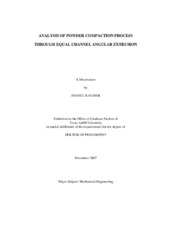| dc.description.abstract | A thermodynamic framework was presented for the development of powderconstitutive models. The process of powder compaction through Equal ChannelAngular Extrusion (ECAE) at room temperature was modeled using the finiteelement analysis package ABAQUS. The simulation setup was used to conduct aparametric study involving varying the process parameters of ECAE, aimed ataiding the process design.Two powder compaction models, the Gurson model and the Duva and Crowmodel, were used to test their efficacy in modeling this process. Thethermodynamic framework was applied to derive the constitutive equations of theDuva and Crow model. Modeling parameters like friction coefficients, interactionconditions were determined by comparing the simulations for solid billet and anempty can with actual experimental runs for loads, shear angle and workpiece geometry. The simulations using the two powder constitutive models showed nosignificant difference in the stress in the powder during the extrusion.The results obtained from the 3-D simulations were also compared toexperiments conducted to compact copper powder with a size distribution of 10mto 45m. It was found through experiments that the powder does not fullyconsolidate near the outer corner of the workpiece after the first ECAE pass and theresults from the simulations were used to rationalize this phenomenon.Modifications made to the process by applying a back pressure during thesimulations resulted in a uniformly compacted powder region.Further, simulations were carried out by varying the process parameters likethe crosshead velocity, the friction coefficient between the walls of the die and thecan, can dimensions and material, shape of the can cross section etc and the effectof each of these parameters was quantified by doing a sensitivity analysis. | en |


